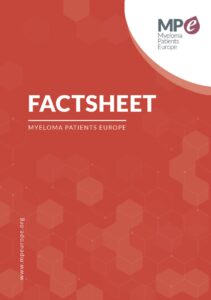What is belantamab mafodotin (Blenrep®)?
Belantamab mafodotin is a first in class antibody drug conjugate approved in Europe in 2020 for use in myeloma patients. It is used by itself in patients who have already received treatment with four previous lines of therapy (including a proteosome inhibitor, an immunomodulatory agent, and an anti-CD38 monoclonal antibody) and still experience worsening of their disease.
As multiple myeloma is considered a ‘rare disease’ because of the small number of patients with this disease, belantamab mafodotin was granted ‘orphan drug designation’ by the European Commission. An orphan drug designation is a status assigned to medicines developed for rare disease conditions that affect fewer than 5 patients per 10,000 inhabitants in the EU.
How does belantamab mafodotin work?
Belantamab is an antibody drug conjugate which consists of a monoclonal antibody (a laboratory engineered antibody) which is bound to a chemotherapy agent (maleimidocaproyl monomethyl auristatin F) that has been designed to recognise and bind to the BCMA protein (a protein found on the surface of myeloma cells). By attaching to BCMA protein on the surface of myeloma cells, belantamab mafodotin is then taken inside the cells, releases the chemotherapy agent, and directly kills the myeloma cell. In addition, the contents released by the dying myeloma cells activate the immune system to find and destroy more myeloma cells.
What are the benefits of belantamab mafodotin?
Belantamab mafodotin is being evaluated in several studies known as the DREAMM programme. The safety and efficacy of this drug by itself was demonstrated in the DREAMM-2 study. In this study 97 patients with relapsed or refractory myeloma received a 2.5mg per kilogram dose of belantamab mafodotin and 99 relapsed or refractory myeloma patients received the 3.4mg per kilogram dose of this drug. Of the patients who received the 2.5mg/kg dose, 31% had a complete or partial reduction in their myeloma burden, which lasted for an average of 2.9 months. Of the patients who received the 3.4mg/kg dose, 34% had a complete or partial reduction in their myeloma burden, which lasted for an average of 4.9 months.
Belantamab mafodotin is currently being studied in various combinations in relapsed and/or refractory myeloma patients2.
What are the side-effects of belantamab mafodotin?
Belantamab mafodotin can cause1:
- keratopathy (blurred vision, dry eyes, photophobia, eye irritation) – most common
- thrombocytopaenia (low platelet count – cells which the body uses to stop bleeding)
- infusion-related reactions
- pneumonia or upper respiratory tract infection
- anaemia (low red blood cell count)
- neutropaenia (low white blood cell count; cells which the body uses to fight infections)
- nausea
- diarrhoea
- vomiting
- pyrexia (fever)
- fatigue
Because of the visual changes caused by belantamab mafodotin patients should have an eye examination by an opthamologist at baseline and whilst on treatment. It is recommended that patients use preservative-free artificial tears at least four times daily beginning on the first day of treatment and continue to the completion of treatment1.
How and when is belantamab mofodotin given?
Belantamab mafodotin is given as an infusion (drip) into a vein at a hospital out-patients department or clinic, under the supervision of a doctor who specialises in the treatment of cancer. The recommended dose is 2.5 mg per kg body weight given once every three weeks. The treatment is continued until a patient’s disease worsens or they experience intolerable side-effects or toxicity.
References
- European Medicines Agency. Blenrep (belantamab mafodotin) European public assessment report (EPAR): https://www.ema.europa.eu/en/documents/product-information/blenrep-epar-product-information_en.pdf
- https://clinicaltrials.gov/ct2/results?cond=&term=DREAMM&cntry=&state=&city=&dist=
